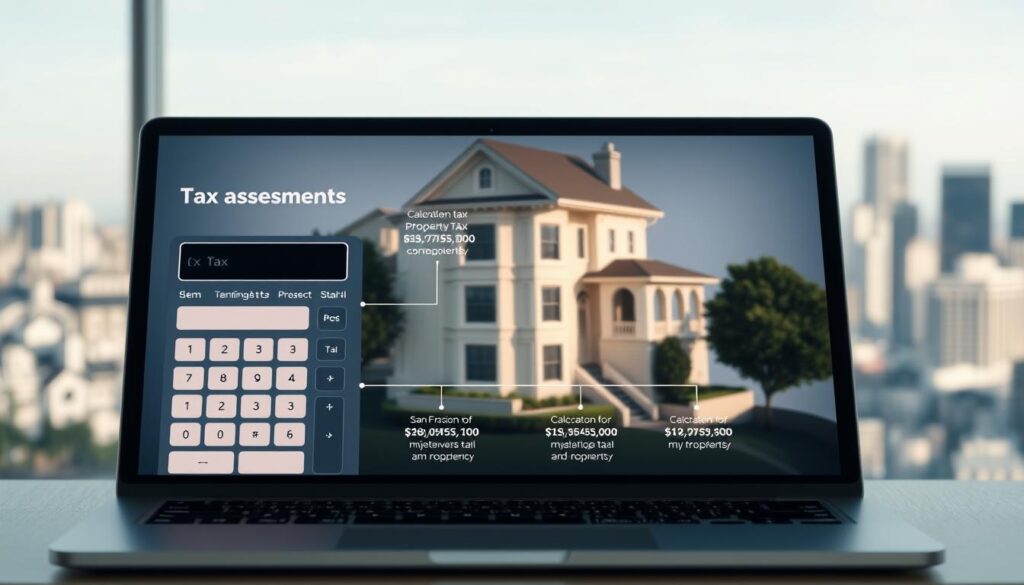Property taxes are key to funding local services in San Francisco. Knowing about California property tax rates helps you understand how the city is financed. These taxes support important community needs like public safety, education, and keeping infrastructure in good shape.
The city’s property tax system is mainly guided by Proposition 13, passed in 1978. This law set the rules for property taxes in California. It makes taxes stable and predictable for homeowners.
If you own property in San Francisco, it’s important to know how taxes are figured out and used. The tax system might seem hard to grasp, but breaking it down helps you make better financial choices.
Table of Contents
Understanding the Basics of San Francisco Property Tax System
San Francisco’s real estate taxes can seem complex. But knowing the basics helps you handle your money better. Property taxes in the Bay Area fund local services and infrastructure.

San Francisco property tax system affects homeowners and investors. The tax rate is 1.1880% of your property’s value. This rate might change each year to meet budget needs.
Current Property Tax Rate Breakdown
- Base tax rate: About 1.2% of property value
- Example calculation: A $1,000,000 property owes $11,880 a year
- Tax rate can change based on city and county needs
Key Components of Property Tax Assessment
Property tax assessment in San Francisco looks at several things. The County Assessor-Recorder’s office sets the property’s value. They consider:
- Purchase price
- Property improvements
- Market conditions
- Potential exemptions
How Property Taxes Support Local Services
San francisco property tax help fund important services. These funds support:
- Public schools
- Emergency services
- Road maintenance
- Parks and recreation
Knowing your property tax system helps you make smart financial choices about real estate in San Francisco.
The Impact of Proposition 13 on Your Property Taxes

In 1978, California voters passed Proposition 13, changing property taxes forever. This law made property taxes more stable for homeowners. It helped protect them from huge tax increases.
The main points of Proposition 13 are:
- Property tax rates are now capped at 1% of the property’s value.
- Annual property value increases are limited to 2% or the inflation rate.
- Properties are reassessed only when sold or significantly improved.
Before Proposition 13, property taxes could jump up a lot. Some properties saw their taxes double in one year. This new law brought stability and predictability to property taxes.
Proposition 13 was a revolutionary approach to protecting homeowners from escalating tax burdens.
This law has had a big impact. It cut property tax rates by about 57%. Now, homeowners face more stable and predictable tax bills. Their taxes can only go up by 2% each year.
A University of California study found that low and middle-income people pay less in taxes now. This is especially good for seniors on fixed incomes. They were most at risk of huge tax hikes.
How Property Tax Assessment Works in San Francisco
Understanding San francisco property tax is key to handling local taxes. The process includes several steps that figure out your annual property taxes.

The San Francisco County Assessor is vital in setting your property’s taxable value. They do a detailed evaluation each year. This ensures your property taxes are fair and accurate.
Market Value Determination Process
Your property’s market value is the heart of San francisco property tax system. The assessment looks at many important factors:
- Current real estate market conditions
- Property’s physical characteristics
- Recent comparable sales in the neighborhood
- Specific improvements or renovations
Base Year Value Calculations
California’s Proposition 13 greatly affects your property’s base value. Here are the main points:
- Base year value is set when you buy the property
- Annual increase is capped at 2%
- Reassessment happens only at sale or new construction
Annual Assessment Adjustments
The San Francisco Assessor-Recorder makes precise annual adjustments. Remember these key dates:
| Date | Assessment Event |
|---|---|
| January 1 | Property Tax Lien Date |
| July | Assessment Notice Mailed |
| September 16 | Regular Appeals Deadline |
Tip: Always review your property tax assessment carefully and keep track of important dates to ensure accurate valuation.
San Francisco Property Tax Calculation Methods
To figure out your property taxes in San Francisco, you need to know a few key things. The san francisco property tax calculator makes it easy to guess how much you’ll pay each year. First, you find out what your property is worth, which is the main part of your tax.

- Base year value established at purchase
- Annual assessment adjustments
- Current property tax rate
- Potential exemptions or relief programs
San francisco property tax has three main ways to figure out:
- Income Approach: Looks at how much rent you could get
- Comparative Sales Approach: Compares your property to others
- Cost Approach: Adds up what it would cost to replace and improve
To find your yearly tax, multiply your property’s value by the tax rate. The san francisco property tax calculator makes this easy. Remember, Proposition 13 caps how much your taxes can go up each year at 2%.
Pro tip: Always check your property’s value and look for tax breaks that can lower your bill.
Today, there are many online tools to help you understand your property taxes. Use the san francisco property tax calculator to get a close estimate. This way, you can plan your budget better for the year.
Understanding the Three Major Property Valuation Approaches
Assessors in San Francisco use three main methods to value properties for tax purposes. These methods help find a property’s market value. This value affects your california property tax rates.

Valuing properties is a detailed task that looks at many factors. Each method gives a different view of a property’s market worth.
Comparative Sales Approach
The comparative sales method looks at recent sales of similar homes in the area. It considers:
- Recent sale prices of similar homes
- Adjustments for property features
- Location and property condition
Cost Approach Methodology
This method figures out a property’s value by calculating the cost to build it again. It looks at:
- Land value
- Construction costs
- Depreciation
- Current market conditions
Income Approach for Commercial Properties
For properties that make money, like rental homes, the income approach is used. It looks at:
- Potential rental income
- Operating expenses
- Capitalization rate
| Valuation Approach | Best Used For | Key Consideration |
|---|---|---|
| Comparative Sales | Residential Properties | Recent Neighborhood Sales |
| Cost Approach | New or Unique Properties | Replacement Cost |
| Income Approach | Commercial Real Estate | Potential Rental Revenue |
Knowing these valuation methods helps you understand how your property’s tax assessment is made in San Francisco.
The Role of San Francisco County Tax Assessor
The San Francisco County Tax Assessor is key in managing property values and taxes. This official makes sure property taxes are fair for everyone. They figure out the taxable value of properties in the county each year.
Some main tasks of the San Francisco County Tax Assessor are:
- Discovering and documenting all taxable properties
- Determining the fair market value of real estate
- Maintaining comprehensive property assessment records
- Applying state guidelines for property valuation
In 2024, San Francisco’s property values went up by 2.12%. This shows the hard work of the county tax assessor. The office uses three main ways to value properties:
- Comparative Sales Approach: Looks at similar property sales
- Cost Approach: Figures out replacement and construction costs
- Income Approach: Checks potential rental income for commercial properties
Property owners can reach out to the San Francisco County Tax Assessor’s office in many ways. This includes asking about property values and appealing assessments. Knowing their role helps you better understand property taxes.
| Assessment Method | Key Characteristics |
|---|---|
| Comparative Sales | Analyzes recent similar property sales |
| Cost Approach | Estimates property replacement expenses |
| Income Approach | Evaluates potential rental revenue |
Remember, Proposition 13 limits property assessments. They can only go up by 2% or the inflation rate, whichever is lower. This rule keeps property taxes stable for San Francisco residents.
Important Deadlines and Payment Schedule
Understanding bay area property taxes is key. San Francisco property owners must know the payment deadlines. This helps avoid penalties and keeps you in good standing with local tax authorities.
San Francisco has a two-part property tax payment system each year. Knowing these dates is crucial for managing your taxes well.
First Installment Requirements
The first payment is due on November 1st. Here are some tips to help you:
- Mark your calendar for the November 1st deadline
- Prepare payment documentation in advance
- Choose from multiple payment methods
- Keep confirmation of your payment
Second Installment Guidelines
The second payment is due on February 1st. To stay ahead, consider these steps:
- Review your property tax bill carefully
- Verify the exact amount due
- Plan for the February 1st payment
- Set up automatic payments if possible
Late Payment Consequences
“Timely tax payments are crucial for maintaining your property’s financial health and avoiding unnecessary penalties.” – San Francisco Tax Assessor’s Office
Late payments can lead to big penalties. The county charges:
| Days Overdue | Penalty Percentage |
|---|---|
| 0-30 days | 10% additional charge |
| 31-60 days | 15% additional charge |
| Over 60 days | 20% additional charge |
Pro tip: Always set reminders and plan ahead to avoid these costly late payment penalties in your bay area property taxes.
Property Tax Exemptions and Relief Programs in Bay Area
Understanding property tax in San Francisco can be tricky. But, there are many relief programs to help homeowners lower their taxes. Knowing about these exemptions can save you a lot of money each year.
San Francisco has several property tax exemption programs for different people:
- Homeowners’ Exemption: Eligible homeowners can get up to $7,000 off their property’s value. This could save you $70-$80 a year.
- Veterans with disabilities might get partial or full property value exemptions.
- Nonprofit organizations can get welfare exemptions for properties used for religious, scientific, or charitable purposes.
- Commercial fishing boat owners might see reduced property assessments.
The city also has special programs like Proposition 19. It changes property tax benefits for certain groups, including:
- Seniors transferring property values
- Severely disabled individuals
- Natural disaster victims
To see if you qualify for property tax relief in San Francisco, contact the Assessor-Recorder’s office. They are at City Hall, Room 1901. They can help you understand which exemptions you might be eligible for.
Pro tip: Always check with the official San Francisco tax assessor’s office to see how you can save the most.
Understanding Supplemental Property Taxes in San Francisco
San Francisco has a special part of its property tax system. It’s called supplemental property taxes. These taxes happen when big changes occur in a property’s ownership or structure.
These taxes are triggered by certain events that increase a property’s value. Knowing what these events are can help you prepare for extra taxes.
Key Triggering Events for Supplemental Assessments
- Property changes ownership
- New construction is completed
- Significant property improvements are made
- Property undergoes substantial renovations
Calculation Methods for Supplemental Taxes
The taxes are figured out by comparing the old and new assessed values. This means you’ll pay taxes based on the property’s new value.
For instance, if a home was worth $800,000 and sold for $1,500,000, you’ll get a tax bill for the difference. The amount you pay is based on the time from the change to the end of the fiscal year.
Timeline for Supplemental Tax Assessments
After a big change, you’ll get a notice from the San Francisco County Assessor’s office. This notice usually comes a few months after the change.
These taxes are on top of your regular property tax bill. So, it’s important to plan your finances if your property goes through big changes.
Property Tax Assessment San francisco Appeals Process
Understanding the san francisco property tax assessment appeals process can be tough. But knowing your rights helps you fight unfair valuations. The Assessment Appeals Board (AAB) is here to help property owners challenge their tax assessments.
To appeal california property tax rates, follow a clear plan:
- Review your property assessment carefully
- Gather supporting documentation
- Understand the key appeal windows
- Prepare comprehensive evidence
The appeal process has two main parts. First, you can request an informal review from January 2 to March 31. This step is free and lets you submit sales data to challenge your property’s value.
If the informal review doesn’t help, you can file a formal appeal with the Assessment Appeals Board from July 2 to September 15. You’ll need to pay a $60 fee and bring strong evidence to support your claim.
Only about 5% of taxpayers actually appeal their property tax assessment, which means many potential savings go unclaimed.
For a successful appeal, consider these points:
- Prove your property’s market value is less than the assessed value
- Show at least two recent comparable sales
- Point out any big changes in your property’s condition
- Know about Proposition 8’s temporary value reduction rules
Even though the process seems complex, many property owners lower their taxes by presenting a strong case to the Assessment Appeals Board.
The San Francisco Property Tax Calculator Guide
Understanding property taxes in San Francisco can be tricky. But, the San Francisco property tax calculator is a great tool for homeowners. It helps you estimate your annual tax by inputting your property’s details.
To use the calculator, you need to know your property’s assessed and market values. You also need to know about any exemptions you might have. The calculator uses San Francisco’s tax rate to give you an estimate. But, remember, it’s just an estimate and not the official tax assessment.
Property tax calculators consider things like Proposition 13, which limits tax increases to 2% a year. With San Francisco’s median home value at $1,348,700, knowing your tax burden is key for planning. Use these tools to get a first look at your tax responsibilities and prepare for payments.
Remember, local assessments, special district fees, and exemptions can change your tax bill. The San Francisco property tax calculator is a good start. But, talking to a local tax expert can help you understand your taxes better and find ways to save.

